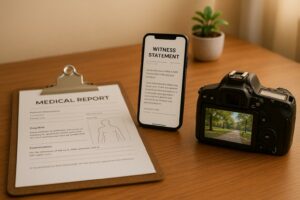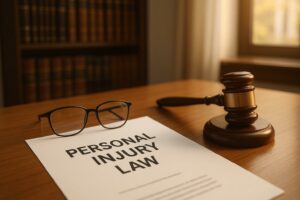If you’ve been injured due to someone else’s negligence, proving pain and suffering is key to getting fair compensation. Here’s how to document and strengthen your claim:
- Start Immediately: Keep detailed records from the moment of injury.
- Use Medical Records: Collect physician notes, test results, and treatment plans.
- Maintain a Pain Journal: Track daily pain levels, missed activities, and emotional effects.
- Gather Statements: Ask family, friends, and coworkers to document changes they’ve observed.
- Provide Visual Evidence: Photos, videos, and proof of lifestyle changes can be powerful.
- Seek Expert Opinions: Doctors, mental health professionals, and vocational experts can validate your claim.
Quick Tip: Consistency in medical treatment and documentation is crucial. Missing appointments or delaying care can weaken your case.
For a strong claim, organize your evidence, avoid common mistakes, and consider legal help to navigate negotiations with insurance companies effectively.
What Are Pain and Suffering Damages?
Pain and suffering damages aim to compensate for the physical pain and emotional distress experienced after an injury. Unlike economic damages, which cover measurable costs like medical bills or lost income, these damages focus on the less tangible ways an injury affects your life.
Physical pain might involve ongoing discomfort or difficulty performing everyday tasks. Emotional distress can include anxiety, depression, or other psychological challenges stemming from the injury.
Types of Non-Economic Damages
Here’s a breakdown of common non-economic damages:
| Type of Damage | Description | Examples |
|---|---|---|
| Physical Pain | Compensation for persistent physical discomfort | Chronic pain, limited mobility |
| Emotional Distress | Compensation for mental and emotional suffering | Anxiety, depression |
Who Can Claim Pain and Suffering?
Most personal injury cases allow individuals to seek compensation for pain and suffering if someone else’s actions caused their injuries. To qualify, you’ll need to show how the injury has significantly disrupted your life, whether through physical pain or emotional challenges. Building a strong case often involves collecting detailed evidence, which will be explored further in the following sections.
Required Evidence for Your Claim
To build a strong pain and suffering claim, you need clear documentation showing how your injury has affected your daily life. Here’s a breakdown of the key types of evidence to collect.
Medical Documentation
Your medical records are the backbone of your claim. They provide a detailed account of your injury and treatment. Be sure to gather:
- Physician notes and treatment plans
- Records from emergency room visits or hospital stays
- Diagnostic test results like X-rays, MRIs, or CT scans
- Physical therapy progress reports
- Details of prescribed medications
Keep copies of all related medical bills, insurance statements, and correspondence about your treatment.
Daily Pain Journals
A pain journal can help illustrate the daily challenges you face. Track:
- Pain levels (e.g., "8/10 when standing for more than 10 minutes")
- Activities that worsen discomfort
- Sleep disruptions
- Events or activities you’ve missed
- Emotional effects, like frustration or anxiety
- How well medications manage your pain
Be specific in your entries. For example, instead of saying, "I felt bad", write, "Severe back pain (9/10) prevented me from attending my child’s soccer game."
Statements from Others
Testimonies from people in your life can provide external validation of your claim. These statements can come from:
| Witness Type | What They Should Document |
|---|---|
| Family Members | Daily struggles, mood changes, and relationship effects |
| Friends | Social limitations and changes in behavior |
| Coworkers | Work-related challenges or missed opportunities |
| Supervisors | Job performance issues, attendance problems |
Photos and Videos
Visual evidence can be a powerful way to show the impact of your injury. Capture:
- The progression of visible injuries over time
- Physical therapy sessions or exercises
- Daily activities you can no longer perform
- Use of medical devices, like crutches or braces
- Any home modifications made to accommodate your injury
These materials can help paint a clearer picture of how your injury has changed your life.
Expert Support for Your Case
Expert opinions add depth to your documentation by confirming and explaining the extent of your pain and suffering.
Doctor Testimony
Medical professionals provide critical evidence about your injury through:
- Detailed assessments of injury severity and recovery timelines
- Reports on long-term health outlooks
- Statements about required treatments
- Documentation of physical limitations
These experts break down complex medical concepts, showing how your injuries disrupt daily life and routines.
Mental Health Reports
Physical injuries are just one part of the story – mental health evaluations capture the emotional impact. These evaluations often include:
| Assessment Area | What It Shows |
|---|---|
| Emotional Impact | Issues like depression, anxiety, sleep problems, and social withdrawal |
| Coping Skills | Difficulties managing stress or adapting to changes |
| Relationship Effects | Strain on family life and social interactions |
These reports highlight the emotional strain tied to your injuries, helping to establish a complete picture of your suffering. They also complement analyses of how your professional life has been disrupted.
Work Impact Analysis
Vocational experts focus on how your injuries affect your career. They examine:
- Current limitations in your job
- Career changes caused by physical restrictions
- Need for retraining or new skills
- Workplace adjustments required for you to continue working
They back up their findings by comparing:
- Your earnings before the injury
- What you’re capable of now
- Industry standards and expectations
- Long-term career prospects
This analysis provides clear, measurable evidence of the financial impact your injuries have had, making your claim stronger with hard data.
sbb-itb-68ed374
Making Your Case Strong
Present clear and well-organized evidence to demonstrate the pain and suffering you’ve endured.
Writing Your Demand Letter
When drafting your demand letter, highlight the physical, emotional, and financial effects of your experience. Here’s what to include:
| Component | Key Elements to Include |
|---|---|
| Physical Impact | Daily restrictions, ongoing symptoms, and needed treatments |
| Emotional Effects | Changes in mood, relationships, and overall quality of life |
| Financial Burden | Medical bills, lost income, and future care expenses |
| Documentation | Evidence such as medical records and expert statements |
Use specific examples to show how your life has changed. Once your letter is finalized, be ready to handle any challenges from the insurance company.
Dealing with Insurance Companies
Keep detailed records of every interaction, respond promptly, and focus on factual evidence. A few tips to keep in mind:
- Avoid accepting initial offers or discussing long-term medical needs too early.
- Steer clear of posting about your case on social media.
- Respond quickly to any requests for information.
- Stick to evidence-based arguments when negotiating.
Insurance companies often minimize non-economic damages. If negotiations stall, seeking legal support can strengthen your position.
Getting Legal Help
At Ocala Injury Law, the attorneys develop well-documented cases to fully demonstrate pain and suffering. Their approach relies on evidence like medical records and personal journals to build a strong strategy for negotiations.
"At Ocala Injury Law, we pride ourselves on providing personalized attention and dedicated service. Our boutique approach ensures that every client receives the care and expertise they deserve."
Their services include:
- Thorough documentation of your case
- Coordination with expert witnesses
- Strategic negotiations with insurers
- Preparation for potential litigation
Legal assistance often results in better settlement offers and quicker resolutions to claims.
Common Mistakes to Avoid
Mistakes in a pain and suffering claim can hurt your case. One key factor? Keeping up with your medical treatment. Any gaps in care might make others question how severe your injury really is.
Gaps in Medical Treatment
Missing medical appointments or delaying treatment can damage your claim. Here’s how to stay on track:
- Go to every scheduled appointment.
- Stick to the treatment plan your doctor provides.
- If you miss an appointment, document why.
- Get referrals quickly if your doctor recommends additional care.
Staying consistent with your medical care helps strengthen your claim and keeps you prepared for the next steps in the legal process.
Next Steps
Now that you’ve thoroughly documented your pain and suffering and avoided common mistakes, it’s time to act. Protect your legal rights by taking the next steps. A skilled legal professional can review your evidence and help strengthen your case.
Get in touch with Ocala Injury Law for tailored legal assistance and a free consultation. Their team is committed to helping you understand your rights and evaluate your options. They can help illustrate how your injury has impacted your daily life, work, and personal relationships – both immediately and in the long term.
Here are a few important steps to take as you move forward:
- Organize all medical and legal records in chronological order, and keep them updated as your treatment progresses.
- Make sure no records are missing or outdated.
- Collect any remaining witness statements or expert opinions that support your claim.
Taking these steps without delay is critical in protecting your rights. Acting quickly and seeking professional legal advice can make a big difference in the strength of your personal injury claim.
FAQs
What’s the best way to document pain and suffering for a legal claim?
To effectively document your pain and suffering, focus on gathering clear and compelling evidence. Start by keeping a detailed journal of your physical and emotional struggles, including daily pain levels, limitations, and how your injuries have impacted your life. Medical records, therapy notes, and prescriptions are also critical to substantiate your claims.
Additionally, photos of injuries, witness statements from family or friends, and expert testimony can help paint a more complete picture of your experience. These forms of evidence can strengthen your case and demonstrate the extent of your pain and suffering.
For personalized guidance, consult an experienced legal team that understands the complexities of personal injury cases and can advocate for your rights with care and expertise.
What types of expert testimony can help prove pain and suffering in a personal injury case?
Expert testimony can play a crucial role in demonstrating pain and suffering in a personal injury case. Medical professionals, such as doctors or specialists, can provide detailed insights into the extent of your injuries, the treatments required, and the long-term impact on your quality of life. Mental health experts, like psychologists or therapists, can also testify about emotional distress, anxiety, or trauma you’ve experienced as a result of the injury.
Additionally, vocational experts may be helpful in explaining how your injuries have affected your ability to work or perform daily activities. These testimonies, combined with thorough documentation, can strengthen your claim and ensure your pain and suffering are properly recognized and valued.
What mistakes should I avoid when proving pain and suffering in a personal injury claim?
When building a pain and suffering claim, it’s important to avoid common pitfalls that could weaken your case. First, don’t rely solely on verbal statements – ensure you have strong evidence, such as medical records, photographs, or expert testimony, to support your claim. Second, avoid exaggerating your injuries or symptoms, as this can damage your credibility. Finally, failing to document your experience, such as keeping a journal of how your injuries impact your daily life, can make it harder to prove the full extent of your suffering.
Working with an experienced attorney can help you navigate these challenges and build a compelling case. A firm like Ocala Injury Law can provide personalized legal guidance to ensure your pain and suffering claim is supported with the right evidence and presented effectively.




